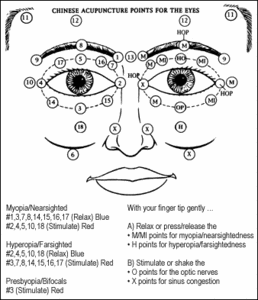One of the longest nerves in the body is known as the vagus nerve (VN). The VN is the 10th pair of cranial nerves that originates at the brain stem in the medulla oblongata. This nerve is part of the parasympathetic nervous system, which is a part of the ANS. Research suggests ear acupuncture can activate the VN.
Natural Vision Improvement: An Alternative to Lasik Surgery
When there is a malfunction or disease in the eyes, Oriental medicine often points to the liver and kidneys. As a medical doctor, I have found this many times to be true.
The liver has more than 5,000 enzymatic reactions that affect the metabolism, nutritional composition and chemistry of the blood. Vitamin A is a prime example. Vitamin A enters the bloodstream, is picked up by the eye, and is converted into retinol, a substance necessary for the chemical electrical reaction that allows us to see.
The kidneys are also very important in Oriental medicine and their effect on the health of the eyes. The kidneys affect the brain, eyes, marrow and bones. When the brain is not properly nourished, you may experience ringing in the ears; dizziness; poor vision; and languid idleness.
Chinese acupuncture and herbs assist the liver and kidneys, which in turn help the eyes. Oriental medicine provides a valuable working model for practitioners. Through the meridians, one comes to understand the electrical grid and electromagnetic field of the human body, and the "clearing" of electrical pathways as vital to systemic balance and overall good health. On the face alone, there are 18 acupressure points surrounding each eye and cheek area. In addition to hundreds of other points in the system, each of these facial acupressure points affects the flow of electricity, or life force, and circulation to the eye. Any point, when over- or under-stimulated, can dramatically affect one's vision or ability to focus.
There are six muscles around the eye and one muscle inside the eye. Often these muscles can be too tight or loose, resulting in problems with one's visual acuity. Fortunately, one can employ exercises and acupressure to tighten or loosen these muscles.
Things You Can Do to Improve Your Vision
The superior oblique muscle is one of the first muscles that applies pressure to the eye and causes its shape to change. Thus, it often results in one's need for glasses (see point 7 on the accompanying chart). This is a place from which the superior oblique muscle can be manipulated, causing the muscle to tighten or loosen. When the muscle is too tight, it presses on the eye, which makes the eye too long; thus, it becomes nearsighted or myopic. If the muscle is too loose, it may contribute to the eye becoming too short or presbyopic (farsighted).

To loosen this muscle in nearsightedness, slowly press the acupressure point with your thumb for one second, then release it. It is recommended that you do this for two minutes. It is important to breathe in when applying pressure, and to exhale when releasing it. Make sure you do this slowly! If done too rapidly, it could have the opposite effect. To tighten this muscle in farsightedness, the point must be shaken gently. Don't shake the whole head.
The second muscle that may be too tight in nearsighted people is the inferior oblique. Its origin is at point 15 (see chart), at the side of the nose on the inferior orbital bone. For nearsightedness, start with point 15, press, and release. For farsightedness, shake the point to tighten the muscle and lengthen the eye.
In farsightedness, the eye is too short. Oftentimes, the rectus muscles could be too tight. One of the best ways to test this out is by pressing point 10. This will influence all of the rectus muscles.
Remember:
- To tighten muscles, shake.
- To loosen a point, press and release.
Finally, one more muscle that may contribute to a visual problem is the ciliary muscle, the circular muscle inside the eye. This helps one focus on objects that are close. When the muscle tightens up, objects can be seen further away. If the muscle is too tight, it may contribute to nearsightedness and must be loosened, or pressed and released. If it contributes to farsightedness, then following the pattern, it must be tightened or shaken (access this at point 3 on the chart).
Chinese Herbs That Support the Eyes
Many Chinese herbs support the nutritional and circulatory requirements of the eyes. They include:
Ming Mu Di Huang Wan. Indications: nourishes kidneys, liver; improves eyesight, yin deficiency of liver and kidneys; dryness; uneasy feeling of eyes; photophobia (light sensitivity); amblyopia (loss of sight from disuse); lacrimation; red, itchy eyes; early glaucoma; early cataracts.
Shihu Yeguang Wan. Indications: poor vision; photophobia; feeling of dryness in eyes; fatigue; lumbago; insomnia; night sweats; glaucoma; choroiditis; retinitis; optic neuritis; night blindness.
Shou Wu Pian. Indications: enriches liver and kidney yin (poor eyesight); tonifies blood; strengthens bones and tendons (weakness in legs, can't stand for a long time); relieves dizziness; headaches; tinnitus (ringing in ears); memory problems; enriches bone marrow and sperm.
Lycium-Rehmannia. Indications: dry eyes; poor vision; dizziness; vertigo; tinnitus; macular degeneration.
Cataract Pills. Indications: improves vitality; nourishes blood, liver; early senile cataracts; decreased vision and vague vision from aging; glaucoma; vertigo; diseases before and after an eye operation.
Dong Quai. Indications: relaxes muscle spasms; is good for the liver and cleansing of the blood.



